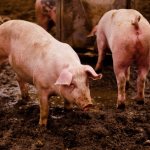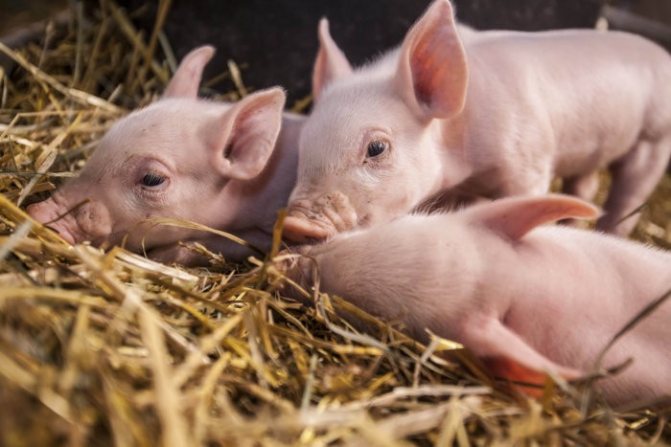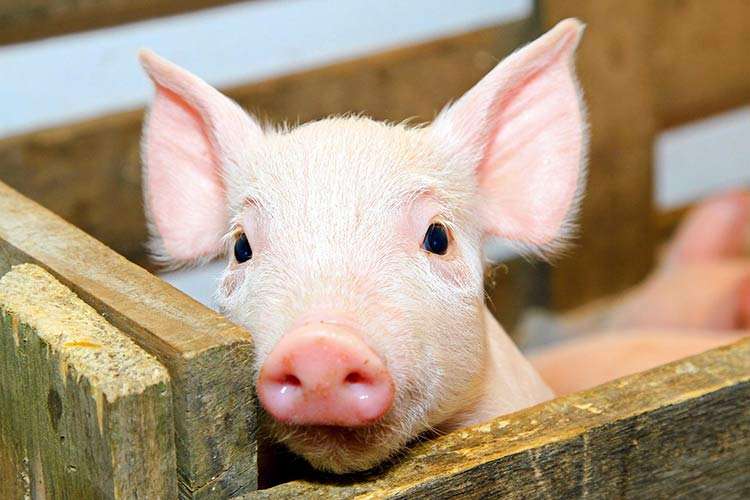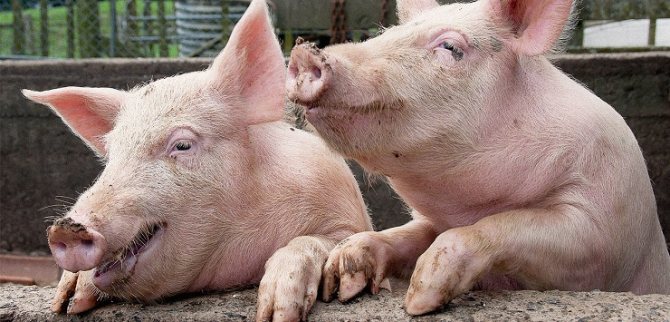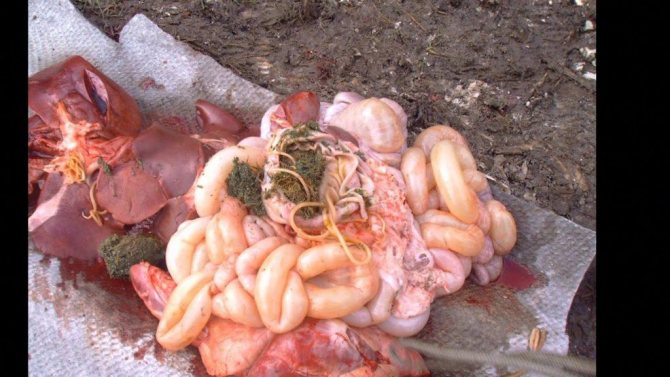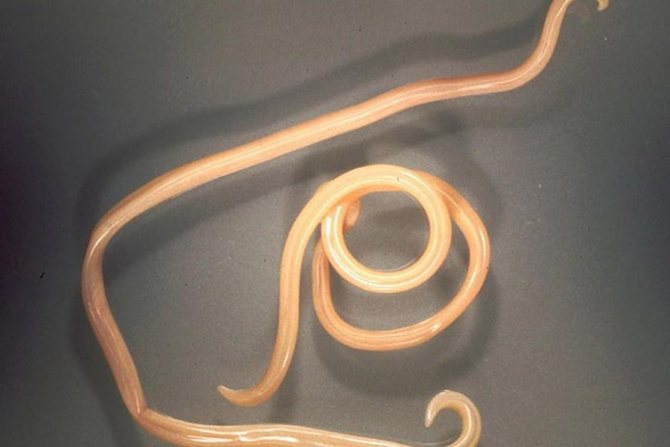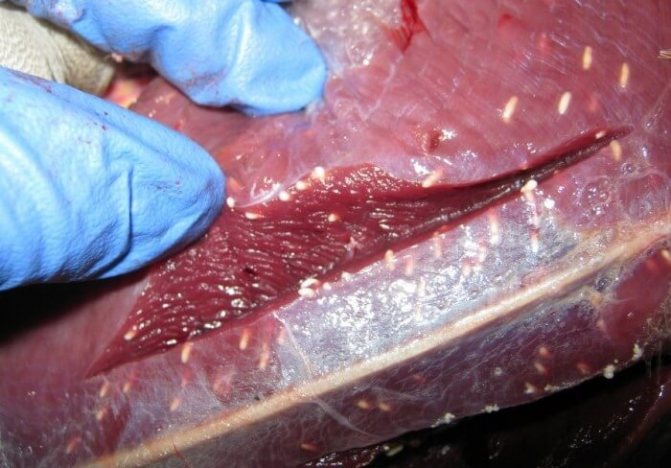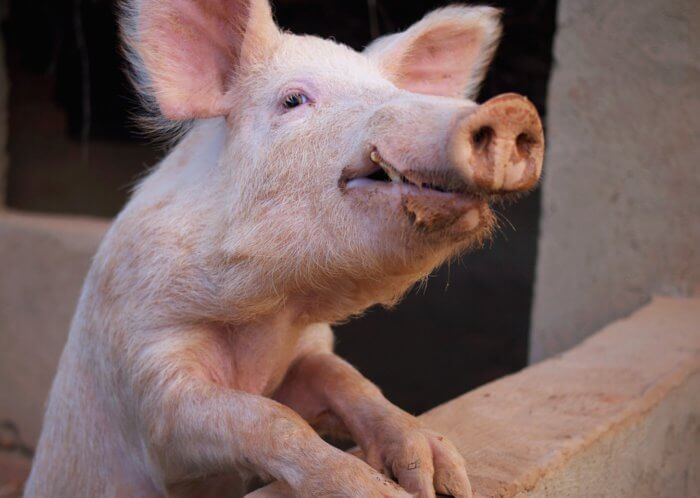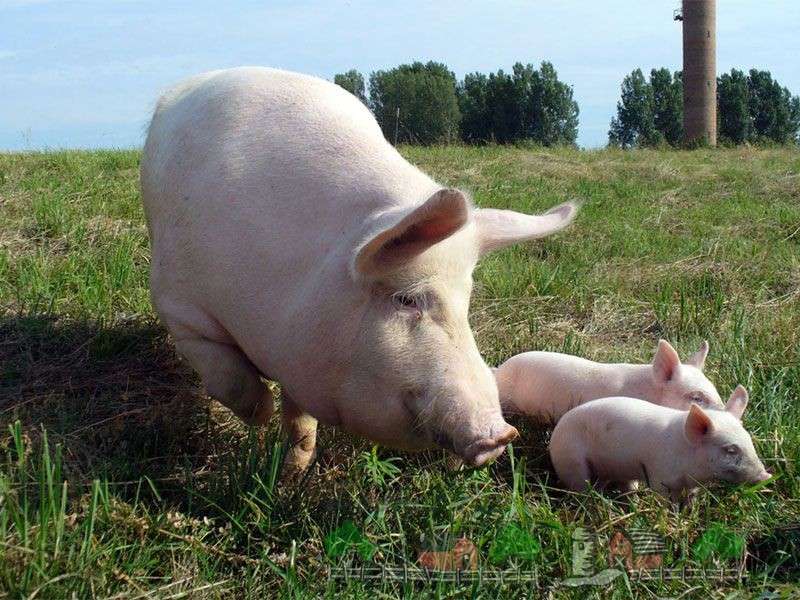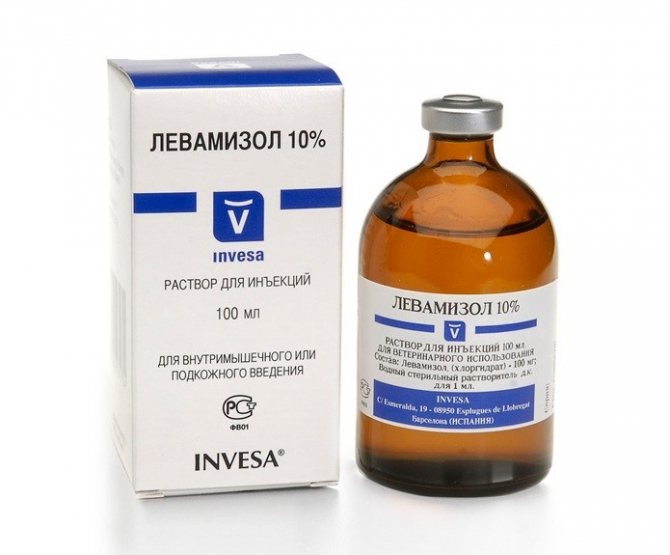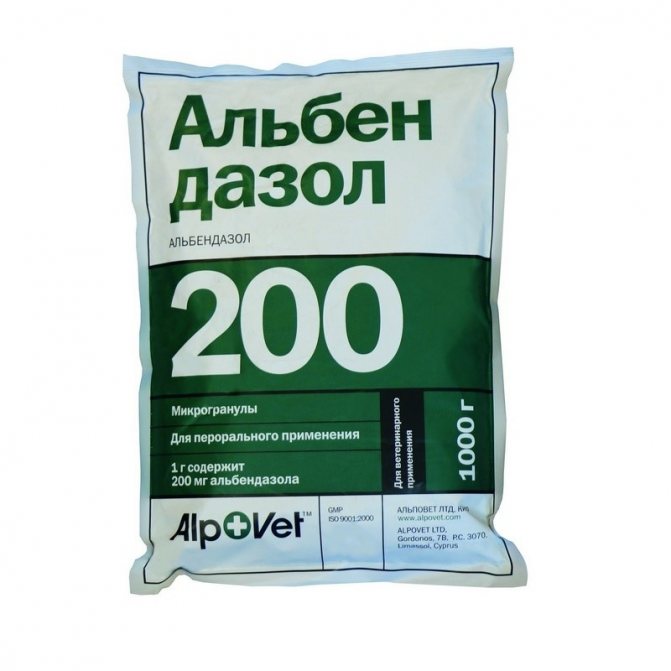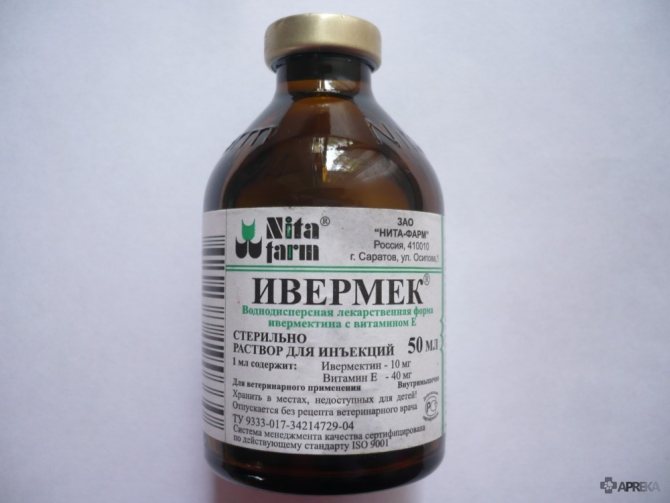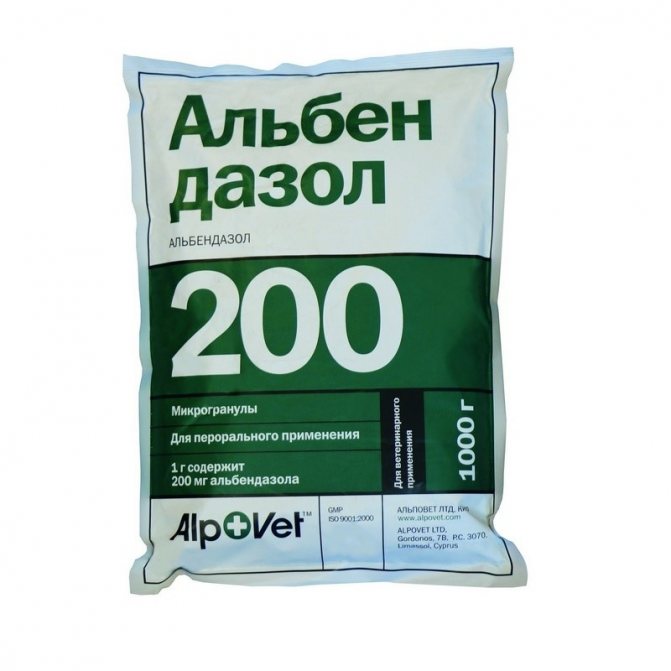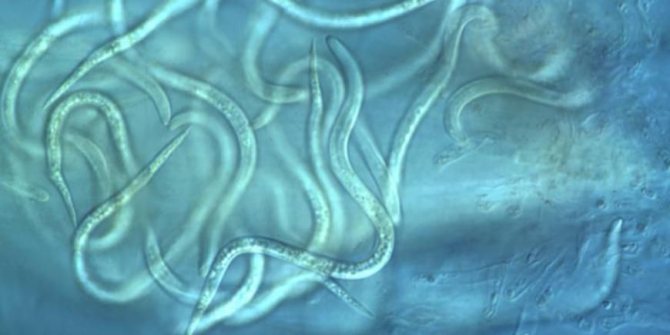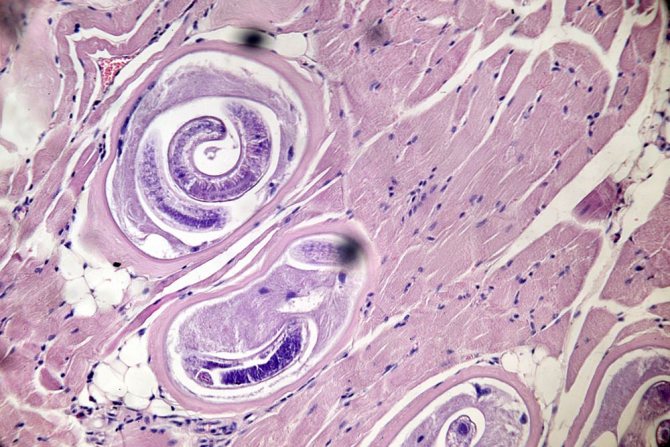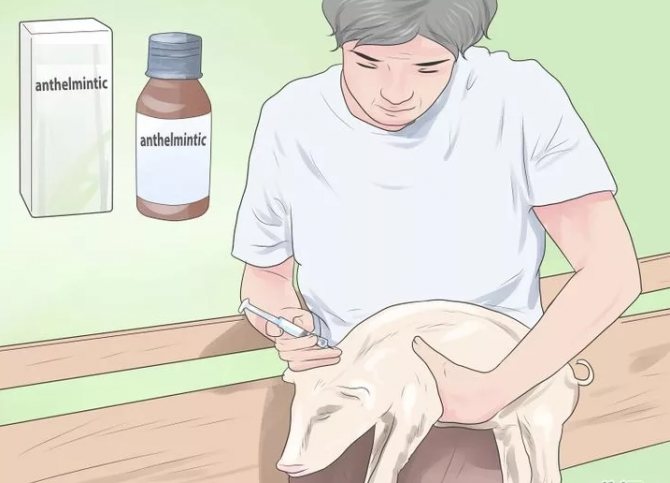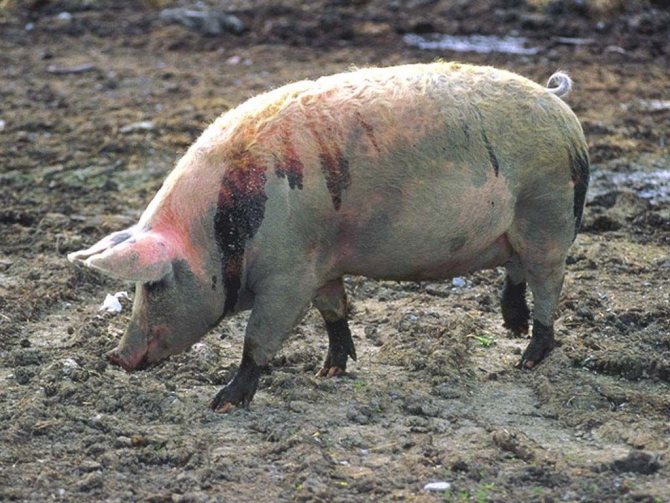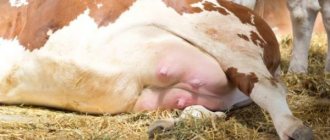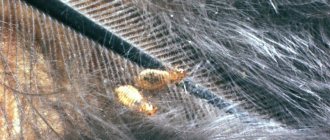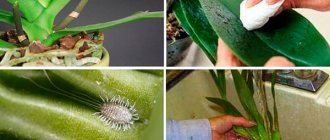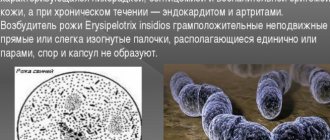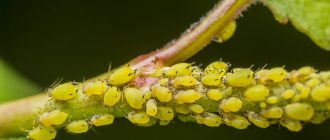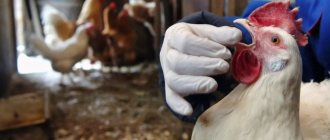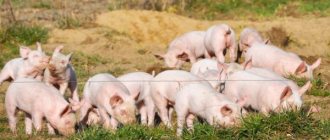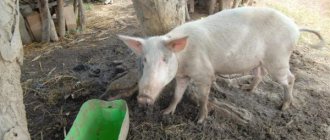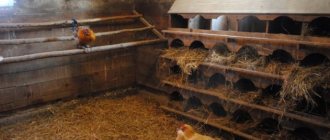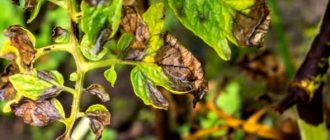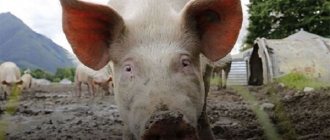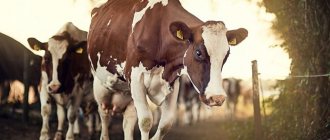Worms in pigs and piglets lead to metabolic disorders, allergies and weight loss in animals. Various types of helminthiasis can also be transmitted to humans, and therefore farmers need to carefully monitor the health of their pets. Signs and symptoms of infection, types of helminthiasis and methods of their treatment will be discussed below.
Pigs infected with helminths
Reasons for the appearance
Infection of pigs with worms occurs most often through the alimentary route, that is, through the mouth. Animals swallow eggs of parasites along with food - grass in the pasture. Eating food and drinking water that has come into contact with the faeces of infected animals is the main cause of helminthic infestation in piglets and adult pigs. In case of mineral deficiency, pigs eat soil, and there may be larvae of worms in it. Suckling piglets are often infected with parasites from the mother, licking helminth eggs from the nipples.
When buying young animals from unfamiliar farmers from the hands, one cannot be sure that they are not infected with some kind of worms. Therefore, it is customary to treat all animals newly arrived at the farm with anthelmintic drugs so that they do not become a source of infection for other inhabitants of the farm. It is important to be careful in order to detect alarming symptoms in time and immediately begin treatment.
Symptoms and signs of worms
Some people are mistaken in thinking that worms are easy to find in the feces of animals. It is not always so. Only a few varieties of worms live in the intestines, others can settle in the liver, lungs, bronchi, brain and other organs. In the feces of animal massage, it is sometimes possible to find only ascaris, which differ in their large size - their length reaches 40 centimeters. Most types of parasites go unnoticed. One can only guess about their presence in the body of an animal by analyzing the behavior of pets and their state of health.
Consider the main signs of worms in pigs:
Depletion of the piglet due to worms
- loss of appetite;
- poor weight gain or even wasting;
- anxiety - animals rub their backs on the floor, do not sleep well;
- cough - often parasites penetrate the nasopharynx of animals, irritating it, or affect the respiratory system;
- the temperature is slightly elevated;
- hoarse grunt;
- dyspnea;
- disorders of the nervous system;
- digestive disorders.
Attention! In some cases, pigs become lethargic and sometimes aggressive.
Types of worms
There are many types of worms, all of which are dangerous. Penetrating into the body of an animal, parasites take away nutrients, vitamins, and in return they release the products of their vital activity. The infected animal suffers from intoxication and rapidly loses weight. Consider what types of helminthiasis are most common in pigs.
Nematodes
Nematode parasites
Roundworms belong to nematodes. They are characterized by the fact that the full cycle of their development takes place in the host's body. There are many types of nematodes, however, most often parasitize in the body of pigs:
- roundworm;
- trichinella;
- metastrongyla.
Roundworms parasitize not only in the intestines, but also in other organs - the bronchi, lungs, causing symptoms similar to bronchopneumonia.Consider each type of nematode for familiarization, we will study the symptoms of infection with these parasites.
Ascariasis
Roundworms are large round worms that mainly affect the small intestine, in rare cases, the bile ducts. Helminth eggs enter the piglets' body with food - grass or water. Ascaris larvae migrate through the bloodstream of the animal, entering the lungs, bronchi, larynx, mouth, after which the pig swallows them. Eventually settling in the intestines, roundworms grow.
Reference. An adult female is capable of producing more than two hundred thousand eggs per day!
Sick piglets burrow into the litter, grind their teeth, sometimes they have cramps, but most often they first have a dry and then a wet cough. With ascariasis, a rash may occur on the body of pigs, diarrhea or constipation are often digestive upsets.
Trichinosis
This type of helminthiasis is caused by nematodes belonging to the genus Trichinella spiralis. Their full development cycle takes place in the body of the owner - the pig. Infection occurs when eating meat that is infected with encapsulated Trichinella larvae. Getting into the stomach of the animal, the protective shell of the capsule is destroyed, a larva emerges from it, which then penetrates into the duodenum. In a matter of hours, it turns into an adult.
Trichinella spiralis
Sexually mature individuals are fertilized, after which the males die. Females are introduced into the intestinal mucosa. Within a week, they give birth to offspring - larvae, which are transferred to the muscles through the circulatory and lymphatic system. There they grow, curl up into a spiral, a capsule forms around the larvae.
Reference. Live larvae can survive in muscle fibers for up to 25 years.
The disease manifests itself:
- an increase in temperature;
- the appearance of a rash;
- swelling;
- inflammation of the muscles;
- severe intoxication.
Metastrongylosis
This disease is caused by nematodes belonging to the genus Metastrongylus elongatus. These are small thin worms - the length of males reaches 2.5 cm, females - 5 cm.The development cycle occurs with the participation of an intermediate host - an earthworm. Metastrongyla eggs enter the intestines of worms when they eat soil. Pigs swallow earthworms, after which the invasive larvae of matestrongyla appear in their intestines. They are introduced into the intestinal mucosa, from where they penetrate through the bloodstream into the bronchi, where they develop. It is in the bronchial tree that the larvae reach sexual maturity and begin to reproduce. Further, the larvae are excreted with phlegm into the pharynx, are swallowed again and enter the intestines.
Signs of infection are:
- cough;
- discharge of mucus from the nose;
- labored breathing;
- diarrhea.
- intoxication of the body - lethargy, loss of appetite.
Attention! The larvae of metastrongyla often cause blockage of the bronchi.
Finnosis (cysticercosis)
This disease is caused by Finns (cysticercus) parasitizing in muscle fibers, which are a translucent vesicle up to 9 mm in length and up to 6 mm in width. They are the larvae of the Taeniarhynchus saginatus cestodes. Inside the capsule there is a liquid and a scolex, which has several suction cups. The parasites mainly affect the skeletal muscle and heart of pigs.
Cysticercosis in pigs
Pigs become infected with Finnosis by eating grass or swallowing cestode larvae, Finns, along with fragments of soil. In the external environment, they are excreted with feces by a person, in whose body a tapeworm parasitizes. That is, pigs are the intermediate host of the cysticercus. In humans, Taeniarhynchus saginatus cestodes parasitize in the small intestine.
Symptoms of the disease in pigs are almost never manifested, so it is very difficult to identify them during life. The invasion is found most often after the slaughter of livestock during the passage of the veterinary and sanitary examination of carcasses.
Scrapers
Another type of helminths are scrapers. They parasitize in the intestine, attaching to its walls with hooks. They enter the pig's body at the egg stage. Intermediate hosts of worms are rhinoceros beetles, May beetles, and bronze beetles. They swallow the eggs of the worms along with the soil. Inside insects, their development takes place. Having swallowed a beetle, in the body of which there are scraper eggs, the pig becomes infected with helminths. The larvae attach to the lining of the small intestine. After 2.5-3 months, they become capable of reproduction.
Symptoms of swine macracantorhynchiasis:
- severe exhaustion;
- anemia;
- bloody diarrhea;
- oppression;
- stomach ache.
Attention! Scratches can kill the animal, as they often cause blockage or perforation of the small intestine, which leads to peritonitis and the formation of abscesses.
Treatment of helminthiasis in pigs
If you suspect a helminthic infestation in piglets or adult pigs, it is important to start treatment immediately. It should be understood that most types of helminthiasis are dangerous to humans. Having found alarming symptoms in an animal, you need to call a veterinary officer, since he must determine what type of helminthiasis the pig suffers from. Treatment can be carried out with the help of special medicines and folk remedies. The first method is much more efficient than the second.
Preparations and tablets
The most effective in the treatment of various types of helminthiasis in animals are drugs based on albendazole and fenbendazole. They are available in powder, suspension, tablet and injection form:
Febtal
- Febtal;
- Cestal;
- Brovadazole;
- Oksilur;
- Panakur;
- Dirofen;
- Alben;
- Albentabs;
- Atazolsept;
- Pratazole;
- Nilverm (injections from worms for pigs) - injected subcutaneously.
These drugs are effective against most types of nematodes, cestodes, trematodes, tapeworms and their larvae. Before using medication, you should consult a veterinarian and carefully read the instructions. Each of these remedies can cause side effects - drowsiness, apathy, however, the condition of the animals soon improves. Anthelmintic treatment is carried out twice.
To give the piglet tablets for worms, they are pre-crushed and mixed into a small portion of feed. It is important that the animal eats it accurately. If a group of animals is being treated, it is easier to use preparations in the form of a powder, which is mixed with a certain amount of food.
The daily portion of feed on the day when deworming is carried out is halved, and after taking the medicine, the pigs are not allowed to eat for several hours (5-7).
The most effective against worms are drugs in the form of injections. When using them, you can be sure that the sick individual has received the required dose of the substance.
Attention! Some anthelmintic drugs are not suitable for piglets under 2 months of age and pregnant pigs.
Folk remedies
Of the folk remedies, garlic and tansy herb are considered the most effective. However, it is better to use them for the prevention of helminthiasis, and it is still worth treating sick individuals with drugs. Garlic is added to pigs' diets every day. It is enough for piglets to eat up to 50-100 grams of vegetables along with feed.
Tansy is effective against worms
The tansy plant is also used to treat worms in pigs. Small piglets weighing less than 30 kilograms are given one teaspoon of dried herb every day.
Note. During and after anthelmintic treatment, it is not recommended to let the pigs out of the pen for several days. Their feces must be collected and burned, and the room must be disinfected.
Worms in piglets are a dangerous phenomenon. The worms parasitizing in the body of a young animal deprive the growing body of nutrients, weaken the immune system, and cause intoxication. All this leads to exhaustion, and sometimes to the death of livestock.For the farmer, this situation is not profitable, so it is important to learn how to recognize the signs of worm infestation and take immediate action. Treatment of helminthiasis should be prescribed by a veterinarian, and the owner of the farm should follow all his instructions and timely deworm the livestock.
Worms annoy not only people. They can also parasitize in the body of any domestic animal, including pigs. As soon as only one individual from the herd becomes infected, all the rest will soon be infected. In addition, meat from a sick animal without proper heat treatment can cause illness in humans. That is why it is so important to detect the presence of worms in piglets at the initial stage of infection.
Causes of the appearance of worms
Worms in piglets and adults can occur for several reasons:
- Pigs are lovers of digging in earthen soil, while at the same time eating its contents. Together with such "food", the eggs of parasitic larvae can enter the animal organism, which, in the presence of favorable conditions, begin to multiply in an active mode, which subsequently leads to the appearance of worms from the eggs.
- There is a high likelihood of infection through the manure of infected individuals.
- Also, infection can occur by drinking unclean water or walking on grass containing helminth larvae.
- An infected female who is breastfeeding can infect the young through milk.
When buying piglets from unknown and unverified sellers, you should be prepared for their possible infection. For this reason, it is advisable for the purchased piglets to arrange a "rut" of worms. At the end of the first procedure, the animals can be placed in the pigsty. However, after one and a half months, the "rut" must be repeated.
Prophylaxis
In order to prevent worms, a number of activities are carried out:
- they clean the pens daily;
- disinfection is carried out with a frequency of 2 times a week;
- whitewash the walls of the pigsty with lime;
- change the litter daily;
- buy piglets only from trusted sellers;
- the first time piglets worms at 1.5 months, then at 3 months and then every quarter.
For the timely detection of infection with worms, it is necessary to carefully monitor the livestock and not ignore individuals with behavioral deviations.
Types of worms
Parasites in pigs can be represented by the following varieties:
Roundworm
Cause a disease called ascariasis. The pathogens have a large body, which in length can reach 35 cm. A special risk zone is young animals in the age range of 3-6 months, as well as decorative pigs. The disease affects adults in rare cases.
The area affected by roundworms is the small intestine, where eggs are laid, which are subsequently released into the external environment along with feces.
Signs of worms in pigs of this variety are as follows:
- disorders in the digestive system, which manifests itself in stool disorders, gag reflex and poor appetite;
- depressive state;
- significant weight loss;
- anemia.
Piggy is suffering from a cough. With the defeat of the larvae of the oral cavity and lungs, pneumonia may develop. If the liver is infected, there is a high risk of developing hepatitis. A large accumulation of roundworms in the intestine can provoke a blockage with subsequent rupture of the organ. Rare symptoms of worms in piglets include:
- allergic reactions;
- convulsive conditions;
- skin rashes;
- seizures of a nervous nature.
Nematodes
Often lead to metastrongylosis, which is understood as the defeat of pigs, which occurs in the form of pulmonary inflammation. The causative agent in length can reach 5 cm, actively multiplying in the bronchi. Before the defeat of pigs, nematodes develop in the body of earthworms, which act as an intermediate carrier.
The disease is especially difficult for individuals of six months of age. Then the signs of worms in piglets will be as follows:
- coughing attacks;
- the appearance of wheezing in the respiratory organs;
- dyspnea.
With the onset of the seventh day, the temperature values of the body begin to increase, which can reach 42 degrees. In the case of a mild infection, the symptoms appear slightly or completely absent.
Cysticerki
They are the Finns tapeworm tapeworm, which provoke a disease called finnosis or grains. The disease can affect almost all types of domestic animals. The causative agents are distinguished by an unusual body structure, which consists of separate segments and can reach a length of one and a half cm, containing many eggs.
Causes and treatment of poor appetite and piglet growth
Often, parasites penetrate the human intestine, where the gradual separation of mature segments from the pathogen begins. After that, they are released outward along with the feces. Pigs become infected when they eat infected human feces.
Symptoms of the disease are quite inconspicuous and mild. Detection of the pathogen becomes possible only with the help of stool analysis.
Trichinella
Provoke trichinosis. The causative agents are small worms, which can reach a maximum of 4 mm in length. The characteristic features are:
- high body temperature values;
- diarrhea;
- vomiting reflex.
The infected individual begins to rapidly lose weight. At the same time, she has painful sensations in the muscle tissues.
Etiology
Environment - soil, grass, floors of a pigsty, infested feed teeming with worm eggs, which fall on the snout of a curious creature. In the intestine of a pig, a larva hatches, which travels through the body, feeds on its juices, causes mechanical injuries, and releases toxic metabolites. The piglets are infected with helminths by the sow, in utero or through milk. Among the frequently occurring helminthic diseases that can be treated, the following are distinguished:
- Ascariasis.
- Metastrongylosis.
- Strongyloidosis.
Ascariasis
The most common helminthiasis among pigs. Adults are relatively large - up to 400 mm - in size. It mainly affects young animals, fattening animals, as well as adult Vietnamese pigs, other decorative and dwarf breeds. Worms in piglets multiply in the small intestine. Eggs must go through a developmental stage in the external environment. Feces from infected pigs contaminate the soil, feeders, drinkers, floors.
From the egg that has entered the intestine, a larva hatch, which is carried by the blood throughout the body. The most acceptable option for her is lungs. The worm feeds, grows, makes holes through which the banal microflora rushes, causing an inflammatory process. When coughing up, the larvae enter the oral cavity, are swallowed, reach the intestines and become sexually mature there.
Roundworms actively feed on digested substances, secrete substances that prevent their absorption. The body is especially affected by the lack of vitamins. The weakening of the pig leads to uncontrolled reproduction of roundworms. They curl into balls, clog the intestinal lumen, rupture of the digestive tube is possible. Wastes of the metabolism of worms poison the body, symptoms of intoxication occur, as well as allergic reactions, manifested in the form of itchy dermatitis.
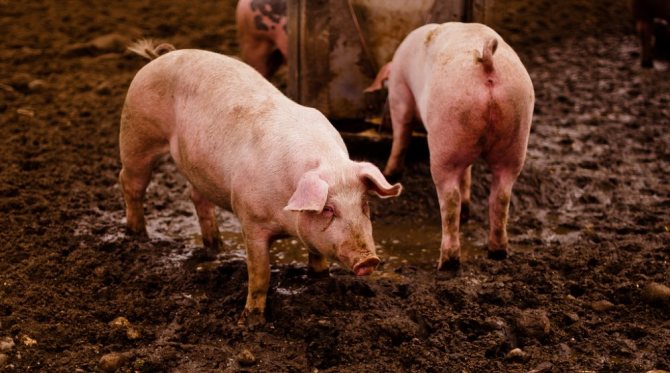
Under such conditions, metastrongylosis is provided
Metastrongylosis
Diseases cause small in size (
- Cough.
- Rhinitis.
- Conjunctivitis.
- Weakness.
- Appetite and body temperature are normal.
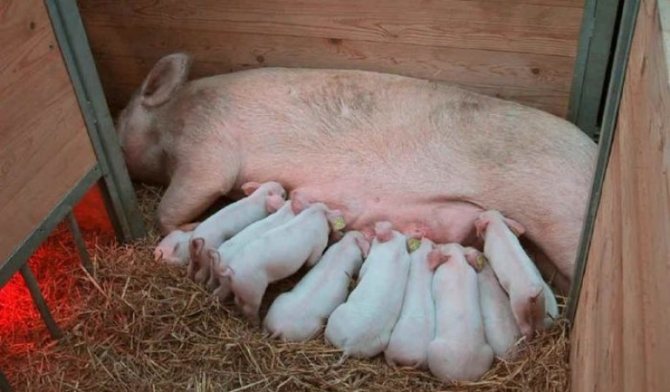

Suckers can catch strongyloidosis from their mother
Strongyloidosis
Slaughtering causes shallow (
- Hyperthermia,> 40.5 ° C.
- Diarrhea.
- Vomiting.
- Itching of allergic origin. A rash forms first, then scabs form.
- Conjunctivitis.
- Pneumonia.The attachment of the second microflora leads to the death of the patient.
Treatment
When faced with such a problem, it is important to know how to get rid of the parasites. If you suspect helminthiasis, the first step is to isolate the infected pigs from the rest of the herd. The rest of the therapeutic measures should be carried out in accordance with the recommendations of the veterinarian and under his supervision. For treatment, the following drugs are used for worms:
Medicines:
- Sodium fluorosilicate. The form of release for piglets is a powder that is poured into the feed for pigs. There are some limitations to consider when applying. So, the medicine should not be given to suckling pigs, as well as to females whose birth is scheduled within a month. For the rest of the individuals, the powdery substance is assigned to courses in three days. The therapeutic effect becomes noticeable with the onset of the second day, when the release of dead parasites outside is noted. Pig intestinal cleansing has an average duration of a week. The largest number of pathogens will be released on the 4th day. The dosage of the drug is calculated in accordance with the body weight.
- Hygrovetin... The product is also an additive to animal feed. Tablets for worms are possible for use in piglets whose age exceeds a couple of months. Feeding with this product is carried out for 35 days. Adults should be given for a couple and a half months. To treat, the dosage is carried out at the rate of 1.5 kg per ton of compound feed.
- Nilverm... Sold as an injection for pigs when subcutaneous injections are required. The injection can be used for pigs of different age groups.
Therapeutic technique
Remedies for worms for pigs exist in the following forms:
- powdery;
- suspensions;
- injection solutions.
In the process of carrying out a therapeutic course, the use of laxatives is excluded. Means produced in powder or syrup form are subsequently mixed with feed, which it is advisable to moisten with water before serving to pigs. On the days when the worms come out, a single portion of food should be halved.
Food intended for young individuals is useful to flavor with dairy whey or meat broth. If the piglet is fed with dry food, the anthelmintic should be mixed with a portion calculated for one day, while reducing it by half.
As practice shows, timely vaccination of pigs against various pathogenic pathogens is the key to a healthy and developing livestock. In this case, it is important to notice pathological manifestations in time, since symptoms and treatment are closely interrelated.
The author of the article
Farmer with 23 years of experience. Agronomist by education. A villager for reasons of principle.
Worms in piglets are one of the most common problems that pig breeders have to deal with. These microscopic parasites can cause significant damage to the farm. If you do not start the treatment of helminthiasis in pigs in a timely manner, then the death cannot be avoided. Prevention and treatment of worms in piglets is described in the article.
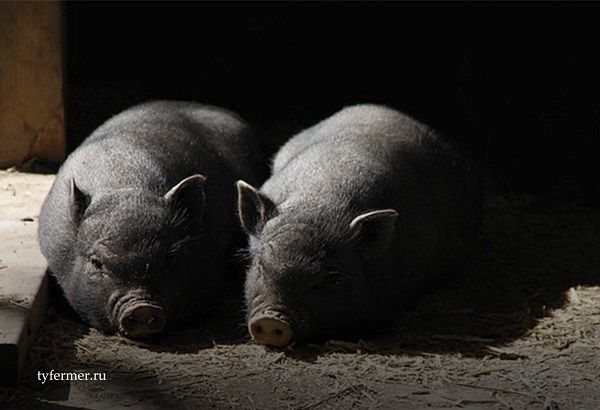

We offer you to find out the symptoms of infection of piglets with helminths
Treatment with folk remedies
Among the traditional methods of treating helminthiasis in pigs, the following recipes can be distinguished:
- Adding fresh garlic to the feed. For 1 kg of animal weight, 1 g is required. garlic, which is thoroughly mixed with the feed and given for a long time.
- Tansy flowers. This method is suitable for pigs weighing over 30 kg. 1 teaspoon of flowers is added to the animal's food and given with the morning portion of food.
It should be understood that traditional methods are not as effective as professional drugs for worms, therefore they are most often used as a prophylaxis.
We suggest that you familiarize yourself with a disease such as scabies in pigs, and also learn how to castrate piglets without the help of a veterinarian.
Preventive measures
To get rid of parasites, it is necessary to disinfect the premises in which the infected animals were kept. Feces should be removed regularly. The manure of infected pigs must be destroyed by incineration. In no case should it be used as a fertilizer.
All procedures are carried out with protective gloves. Worms in pigs are also dangerous for people - do not forget about this when processing. Drinking bowls, feeders need to be doused with boiling water.
Correctly carried out treatment and preventive procedures will avoid re-infection with worms.
The most obvious signs of infection
The first signs of worms in piglets and pigs are slow weight gain by them, poor appetite in animals.
Piglets infected with worms start to coughinfected adult pigs also cough. This is due to the fact that colonies of parasites settle in the nasopharynx of animals, constantly irritating it.
If at the same time you start treating animals for colds, then the cough will not decrease, but, on the contrary, will intensify.
Temperature piglets with helminthic invasion rises, their grunting becomes hoarse, uterine. These symptoms indicate a high sensitivity of pigs to infection with worms, almost like humans.
The experienced gaze of a pig caregiver will immediately notice these changes.
Ascaris in pigs
Often, right in the manure, you can see large roundworms - worms up to 0.4 meters long. In this case, treatment should be started immediately.
In addition sick animals should preferably be separated from healthy pigs as soon as possible... But due to close contact between animals, infection of the entire herd can hardly be avoided.
As female worms continue to lay their eggs in the throats and intestines of animals, the pigs become anxious. They eat poorly, get nervous for no reason, often itch with their sides and are reluctant to come into contact with their relatives.
Some individuals begin to behave aggressively, bite other pigs, while screeching menacingly. This behavior will not change before the worm treatment is started.
Signs of worms in pigs require prompt intervention by a veterinarian who can correctly prescribe treatment.
First symptoms
The first step for farmers is to pay attention to how the pigs eat. When the body is infected with helminths, appetite is significantly reduced. Since piglets grow quickly at an early age, at a certain period you can find a stop in their growth, and the weight is gained very slowly. With a long course of pathology, it will be possible to see how the ribs and ridge appear through the animal's skin. Worms in pigs can be localized not only in the gastrointestinal tract, but also in the throat. As a result of their location, sick individuals may have a cough. The worms themselves can periodically crawl out through the nose. During the day and night, the piglets begin to grind their teeth.
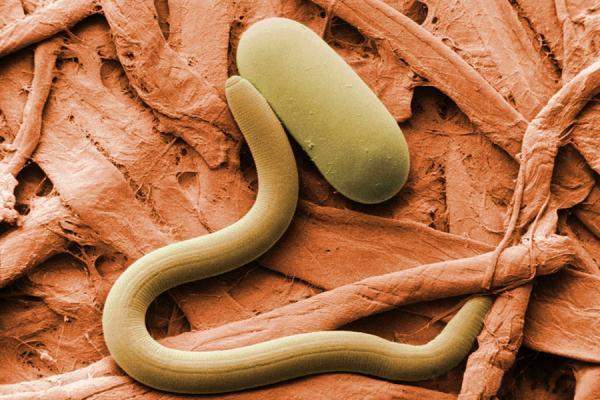

Sometimes the owners begin to treat pigs for viral diseases or colds, but the symptoms of helminthiasis do not disappear. Localization of worms in the throat of sick pigs often provoke their aggressive state, anxiety. Body temperature may rise. When grunting in animals, you can hear the characteristic wheezing. After a while, vomiting and indigestion may begin. Physical activity decreases.
Also, farmers are advised to pay attention to the discharge of animals. In the manure, you can find the worms themselves, which came out with the manure. Adult worms can reach 35-40 centimeters. With the disease, diarrhea may appear, which gradually disrupts the water balance in the body.
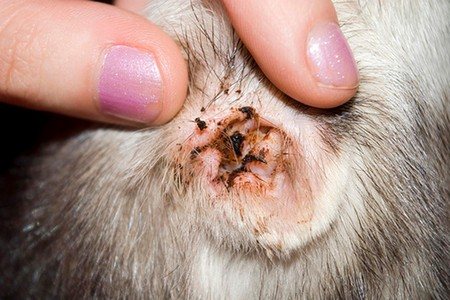

Treatment of helminthiasis in pigs
If you suspect a helminthic infestation in piglets or adult pigs, it is important to start treatment immediately. It should be understood that most types of helminthiasis are dangerous to humans. Having found alarming symptoms in an animal, you need to call a veterinary officer, since he must determine what type of helminthiasis the pig suffers from. Treatment can be carried out with the help of special medicines and folk remedies. The first method is much more efficient than the second.
Preparations and tablets
The most effective in the treatment of various types of helminthiasis in animals are drugs based on albendazole and fenbendazole. They are available in powder, suspension, tablet and injection form:
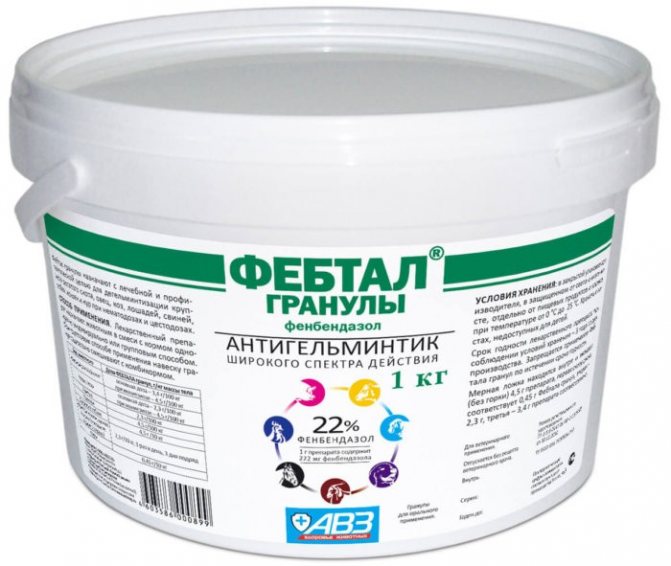

Febtal
- Febtal;
- Cestal;
- Brovadazole;
- Oksilur;
- Panakur;
- Dirofen;
- Alben;
- Albentabs;
- Atazolsept;
- Pratazole;
- Nilverm (injections from worms for pigs) - injected subcutaneously.
These drugs are effective against most types of nematodes, cestodes, trematodes, tapeworms and their larvae. Before using medications, you should consult a veterinarian and carefully read the instructions. Each of these remedies can cause side effects - drowsiness, apathy, however, the condition of the animals soon improves. Anthelmintic treatment is carried out twice.
To give the piglet tablets for worms, they are pre-crushed and mixed into a small portion of feed. It is important that the animal eats it accurately. If a group of animals is being treated, it is easier to use preparations in the form of a powder, which is mixed with a certain amount of food.
Why are worms dangerous?
If the pig is not treated with helminthic infestation, pneumonia, bleeding, edema and emphysema of the lungs, as well as other diseases, are possible as a result. Several adults of the same roundworm may not do much harm, but when there are a lot of them, with their entire mass they are able to block the lumens of the intestines and bile ducts, which eventually causes peritonitis and perforation. Young pigs usually die first.
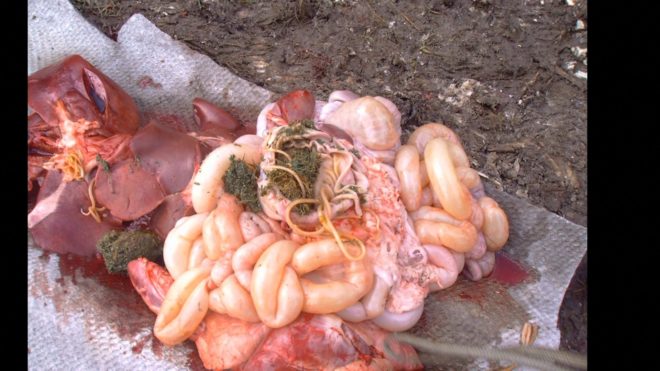

If treatment is not started on time, worms in the animal's body can lead to serious consequences.
Precautions
You need to know that the slaughter of an animal for meat can be done no earlier than a week after the last dose of the medicine.
Parasitic diseases such as echinococcosis or sparganosis do not respond to treatment. The condition leads to the death of the animal. And if a person eats an infected meat product of such an animal, then serious health problems can develop.
Is it okay to eat meat infected with worms? A person can become infected with worms only if they eat the poorly cooked meat of an infected pig. Therefore, raw meat and lard must be bought in stores where they undergo a sanitary inspection. Those who keep livestock themselves need to be vaccinated and hygienic on time.
To kill the eggs of worms in meat, you need to boil or fry it thoroughly. Only at temperatures above +71 degrees do helminths die. You cannot taste a raw product. Use separate knives for lard and meat.
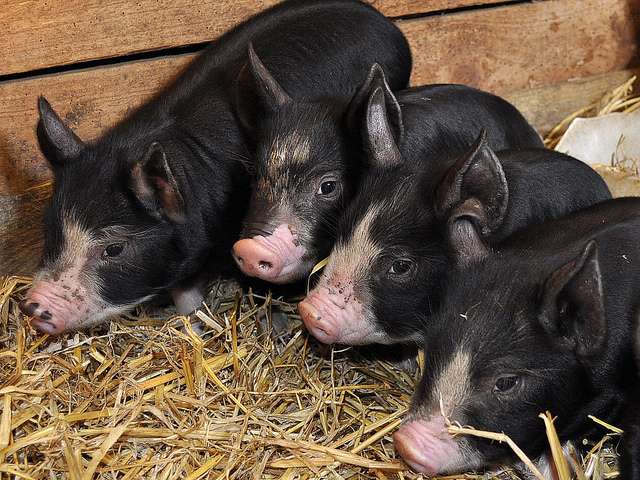

Worms in pork do not die when frozen, salted and smoked. Do not eat contaminated smoked or salted lard. You cannot use such meat for barbecue.
Prevention will help speed recovery and prevent re-infection. Maintain cleanliness in the area where livestock lives. Disinfection of floors and walls should be carried out regularly. Pigs should eat from feeders treated with boiling water every day. Manure must be removed or even burned, otherwise it will become a source of new infection.
What to do and how to treat
If pigs develop warning symptoms, contact your veterinarian.
After determining the type of parasites, drugs are prescribed:
- Nilverm... The drug is administered subcutaneously. The dosage depends on the weight of the pig. For 10 kg of weight, take 1 ml of the drug. For piglets up to 6 months, the dosage is lower and equal to 0.015 g / kg.
- Hygrovetin... For piglets, starting from 2 months, this drug can be prescribed. Add to feed. For 10 kg of feed, take 15 g of the active ingredient. Treatment should be continued for 2.5 months. For prevention, small pigs are given for a month.
- Sodium fluorosilicate... The drug is added to compound feed. The dosage is calculated based on the weight of the animal: 25 g per 10 kg of feed. It should be given within three days. No additional laxatives are required. It is not recommended to treat suckling pigs and lactating sows.
- Albendazole... But the main condition is to isolate the pig from other individuals. The medicine is available in powder form, which is mixed into livestock feed. The dosage is equal to 1 g per 10 kg of body weight of the animal. Give in the morning for 5 days.
Instructions for the use of Levamisole
In the treatment of helminthiasis, drugs are used that have a strong effect on parasites. These include Levamisole (trade name Decaris). The medicine has a detrimental effect on all types of helminthic invasions, especially nematodes (infection with round worms). It is used in the treatment of people, animals (pigs, sheep, goats) and poultry (chickens). The medicine also has an immunomodulatory effect and can be used for oncology and skin diseases. Instructions for the use of Levamisole will acquaint you with the correct use of this drug.
Composition and release forms
The active substance of such a drug is levamisole hydrochloride. It is a derivative of tetramisole, which is an odorless white or slightly pinkish powdery substance, soluble in water and unchanged in acidic media. Degradable in alkalis and neutral liquids.
Preparations containing such an active substance are produced in white or light orange tablets with a dosage of 0.05 g and 0.15 g. They also contain other additional substances: compounds of sodium salts and glycolic acid, purified talc, magnesium stearate, silicon dioxide, starch , calcium salts and phosphoric acid, lactose.
Levamisole hydrochloride is included in the structure of the antibacterial and antiparasitic ointment Misofen. It is white and comes in 100 g jars.
In veterinary medicine, the drug is used in the form of a transparent liquid for injection with a content of 75 mg of the active substance. This drug is called Levamisole 75. It comes in brown glass vials. The composition is used for injection:
- cattle;
- pigs;
- sheep;
- goats;
- dogs.
Chickens can be given Levamisole 10. The drug is available in bottles of 50, 100, 250 ml, hermetically sealed with rubber stoppers. Distilled water is an auxiliary substance here.
Mechanism of action
The active substance - levamisole hydrochloride - counteracts the synthesis of fumarate reductase, inhibits the formation of adenosine triphosphate, which is responsible for playing an important role in the metabolism of parasitic organisms. It also negatively affects the neuromuscular system of worms, inhibits the action of acetylcholinesterase, which ultimately provokes complete paralysis of parasites. Their excretion from the body occurs with the help of peristaltic bowel movements.
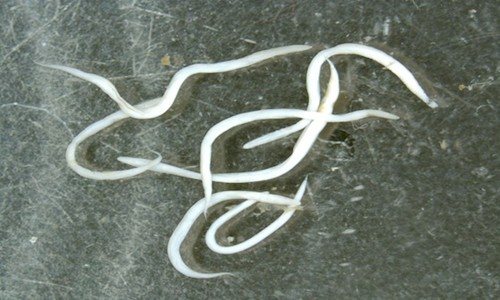

The use of Levamisole is carried out without significant changes in the diet and laxative.
It is absorbed quickly enough by injection. The highest concentration in blood and tissues occurs within an hour. The drug has a therapeutic effect on the body for 7-9 hours.
Appointment and dosage
The medicine in various forms is used to cure a wide range of helminthic invasions in both humans and animals due to the pronounced anthelmintic effect on mature individuals and larval forms of worms. A person receives Levamisole tablets for the following diseases:
- ascariasis;
- non-coronary artery disease;
- strongyloidosis;
- ankylostomiasis;
- trichostrongyloidosis.
Levamisole hydrochloride is taken once at bedtime. The dose is calculated based on the patient's body weight: for 1 kg of weight - 2.5 mg of the drug. Course treatment - three doses at intervals of a week.
Cattle, as well as sheep and goats, are prescribed Levamisole 75 for infections with bunostomiasis, nematodyrosis, ostertagiosis, cooperiosis, dictyocaulosis. Pigs are prescribed injections if they get sick with ascariasis, esophagostomosis, strongyloidosis, trichocephalosis, chiostrongylosis, metastrongylosis. Levamisole 75 is administered intramuscularly (subcutaneously in goats).
How much drug should animals be injected based on their weight? One dose is:
- For cattle - 7.5 ml of substance per 100 kg of body weight. The volume of a single injection should be no more than 23 ml.
- Pigs, sheep and goats - 0.75 ml per 10 kg of body weight. The largest single dose cannot be higher than 4.5 ml.
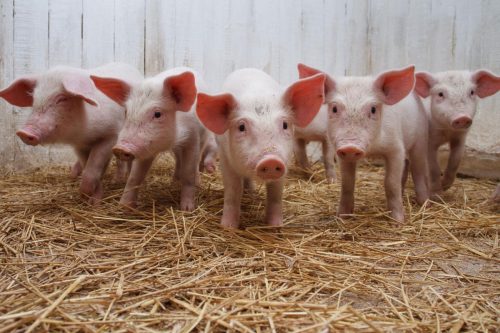

For injection, you can also use Levamisole 10 with a lower concentration of the active substance. Only you need to calculate the dose based on this volume. The medicine in this form is preferred to be given to chickens for the treatment of worms orally for 3 days, 1 ml of medicine per 250 ml of water.
For external manifestations of parasitism, an ointment is used.
Despite the fact that levamisole hydrochloride has shown a fairly high efficiency in getting rid of helminthic invasions caused by nematodes, it is rarely used in human treatment. This is due to its high activity and high toxic effects on the body.
Side effects and contraindications for humans
The medicine is potent, so it is best not to give it to children under 6 years of age. Some women have experienced uterine bleeding while taking Levamisole. Also, during its use, there may be such side effects:
- Nausea and indigestion.
- Vomiting and abdominal pain.
- Ulcerative formations in the mouth.
- Development of pancreatitis.
- Headaches and fatigue.
- Rash on the skin.
- Temperature increase.


This drug is prohibited for use by people with individual intolerance to the components that make up its composition. During the course of treatment, it is strictly forbidden to consume alcohol. This can lead to antabuse syndrome. Levamisole is contraindicated in pregnant women and people suffering from:
- Hepatic and renal failure.
- Impaired blood circulation in the brain.
- Leukemia in the acute stage.
Cautions and limitations
Levamisole 75 and Levamisole 10 are prohibited for use in weakened, malnourished and sick animals. Their introduction is contraindicated in females who are in the last stages of pregnancy and breeding producers during mating.
The drug should not be taken together with antibiotics and within 10 days after their use.
High sensitivity to the active substance of the drug in many animals causes excitement, strong salivation, frequent urination and defecation, impaired coordination of movements. Such symptoms stop on their own, without the use of any additional therapy.
Levamisole for birds and animals is finished giving 7 days before slaughter. If mass slaughter of livestock is required during deworming, the meat is used as feed for carnivores. Milk can be drunk in pasteurized form 2 days after the course of treatment.
Before starting the mass administration of the drug, Levamisole 75 should be tested in a group of 7-10 animals. If no complications are noticed, injections are given to all infected livestock.
Analogues and price
In case of intolerance to the components of the drug, you can resort to the use of drugs that can, to a certain extent, replace Levamisole. These are drugs that contain the same active ingredient. These include:
You will be surprised how many parasites will come out if you drink a glass of ordinary in the morning ...
The parasites will leave the body in 3 days! You just need to drink on an empty stomach ...
- Levazole;
- Levotetramisole;
- Nibutane;
- Casidrol;
- Tenisol;
- Levorpercol;
- Diaphor.
The price of the drug in tablets is from 90 to 110 rubles per package. It depends on the pharmacy network through which the medicine is sold.
Levamisole plus for injection to animals costs from 70 rubles per 100 ml. It and its analogues can be freely purchased at veterinary pharmacies.
Testimonials
In cases where people use the drug in tablets to eliminate parasites sensitive to its active substance, opinions were divided. 62% of those who expressed their impressions were satisfied with the course of treatment and its results, while 38% complained of side effects. Half of those who spoke out against were forced to stop treatment on the recommendation of doctors.


Experts also outlined their point of view regarding the drug. Their reviews are mostly positive, but they categorically do not recommend the use of Levamisole for children under 6-7 years old. For other categories, recommendations were given to carefully read the description and instructions for use of Levamisole.
Veterinarians were also pleased with the use of the drug for injection and ointment with the same active ingredient. Their reviews speak of successful treatments for both cattle and pigs, sheep, goats and chickens.
Ways and methods of treatment of pigs
Worms in pigs can manifest themselves in different types with their own symptoms, respectively, the treatment should be selected taking into account the specific parasite. Today there are two ways to combat worms in farm animals:
- With the use of drug therapy;
- Folk remedies.
The first is the most effective, therefore, it is most often resorted to.
Medicines to combat worms
For the treatment of pigs, veterinarians usually prescribe anthelmintic drugs that have a wide spectrum of action, such as:
- Albendazole
- Fenbendazole
- Febantel
- Levamisole.
Most of them contain several active substances in their composition and have a detrimental effect on both adult worms and larvae.
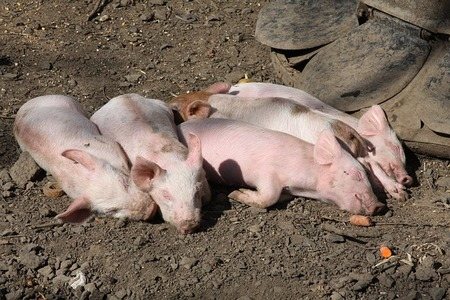

Depending on the age of the sick piglet, the type of drugs and their dosage are determined
With a mild degree of disease in pigs and a well-established diagnosis, drugs with a narrow spectrum of action can be used:
- Nitroquinyl
- Closantel.
But you should know that such medications must be given several times with an interval of one to two weeks, since they only affect adult worms.
Only a veterinarian can accurately diagnose and prescribe therapy. Therefore, when the first signs of worms appear in piglets and pigs, you should not treat yourself, but you should immediately contact a specialist. And prevention of worms will help to avoid infection.
Folk remedies in the fight against helminthiasis in pigs
Man has been keeping this type of farm animals for a very long time. Just like today, in those days, people had to deal with infection of piglets with worms and look for ways to get them out. This is how folk remedies appeared, one of the most popular among which is garlic. The anthelmintic properties of this plant have been known since ancient times, and it is equally effective against parasites in both humans and domestic animals. Pigs add finely chopped garlic to the feed at the rate of 1 gram per kilogram of animal weight.
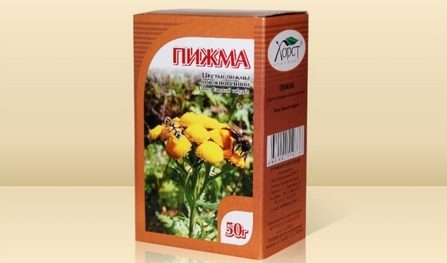

Tansy is added to the food for pigs, and a teaspoon per individual weighing up to 30 kg for piglets is added to the feed.
The second place in terms of efficiency and popularity belongs to the plant - tansy. Its flowers are added to the feed for piglets in a teaspoon per individual weighing up to 30 kg.
But when choosing folk remedies, it is necessary to take into account that worms affect various organs and many of them are immune to herbal preparations. Therefore, the treatment should be prescribed by a veterinarian.
What can be given to piglets with helminthic infestation?
The choice of therapy depends on the age of the animal.The following drugs are most often used in the treatment of piglets:
- hygrovetin;
- nilverm;
- sodium fluorosilicon powder.
Of these, only Nilverm is injected subcutaneously, the rest are added to the feed. But each drug has certain limitations. So sodium fluorosilicate should not be given to piglets that feed on pig milk, as well as to adult pregnant females in the last month.
Gigrovetin is approved for use for young animals older than two months. They give it by mixing it with feed for a month for babies and 70 days for adult animals.
You can defeat parasites!
Tips from our readers
I got rid of parasites in just a week! The remedy I learned about from an interview with a parasitologist helped me.
Toximin® is a parasite remedy for children and adults!
- Dispensed without a doctor's prescription;
- Can be used at home;
- Cleans from parasites in 1 course;
- Thanks to tannins, it heals and protects the liver, heart, lungs, stomach, skin from parasites;
- Eliminates putrefaction in the intestines, neutralizes eggs of parasites thanks to F.
A certified, helminthic-recommended home remedy for getting rid of parasites. Has a pleasant taste that children will love. It consists exclusively of medicinal plants collected in ecologically clean places.
There is a discount now. The drug can be obtained free of charge.


The best stories from our readers
Subject: Parasites are to blame for all the troubles!
From whom: ()
To whom: Administration
For the last few years I have been feeling very bad. Constant fatigue, insomnia, some kind of apathy, laziness, frequent headaches. There were also problems with digestion, bad breath in the morning.
And here is my story
All this began to accumulate and I realized that I was moving in some wrong direction. I began to lead a healthy lifestyle, eat right, but this did not affect my well-being. The doctors, too, could not really say anything. It seems like everything is normal, but then I feel that my body is not healthy.
Then I went to one expensive clinic and passed all the tests, and so in one of the tests I was found to have parasites. These were not ordinary worms, but some specific species, which, according to doctors, almost everyone is infected, to a greater or lesser extent. It is almost impossible to remove them from the body. I took a course of antiparasitic drugs that were prescribed to me in that clinic, but there was almost no result.
A couple of weeks later, I came across an article on the Internet. This article literally changed my life. I did everything as it was written there and after a few days I felt significant improvements in my body. I began to get enough sleep much faster, the energy that was in my youth appeared. The head no longer hurts, there is clarity in consciousness, the brain began to work much better. Digestion has improved, in spite of the fact that I now eat at random. I passed the tests and made sure that no one else lives in me!
Who wants to cleanse their body of parasites, and it doesn't matter what types of these creatures live in you - read this article, I'm sure it will help you 100%! Go to article >>>
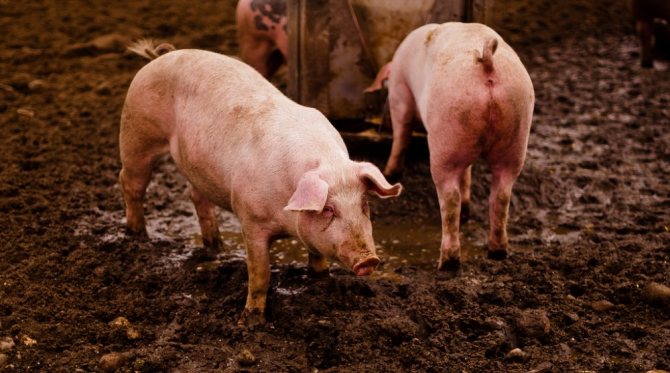

The pig economy suffers from worm infestation. They grow poorly, become susceptible to concomitant diseases. The infestation quickly spreads to the entire swine herd. Many parasitic diseases are unsafe for humans. The purpose of this article is to familiarize livestock breeders with the types of parasites that cause disease in pigs and measures to control them.
Respiratory hookworm
These include roundworms, the mature forms of which are localized in the lungs and respiratory tract of pigs.
Genus Metastrongylus
Adults Metastrongylus elongatus. Live mainly in trachea, bronchi, bronchioles
Spread... It is a pulmonary nematode that is widespread throughout the world and affects mainly pigs and wild boars and, in rare cases, other animals. Species infecting pigs:
- M. elongatus (Metastrongylus apri);
- M. salmi;
- M. pudendodectus.
What does it look like? Adult worms are 2 to 5 cm long and are whitish or yellowish in color. Females are about twice as large as males. The body is covered with cuticles, there are no signs of segmentation. The internal organs are similar to other roundworms. The eggs are about 50x60 micrometers in size and have a thick shell.
Infection routes... Pigs and wild boars become infected after ingesting earthworms, which have previously consumed the larva and act as intermediate hosts. The eggs themselves are coughed up by pigs, but infection is not possible without an intermediate host (earthworm).
Symptoms and Effects... Mass infections cause bronchitis and pneumonia, which are accompanied by coughing and nasal discharge. Weight loss is observed. Other respiratory complications can develop due to secondary infection.
Trematodes (digenetic flukes)
Trematodes affect the liver, pancreas or biliary system of pigs. Their life cycle is complex and always proceeds with a change of several owners. Helminths of this class cause trematodes. Pigs can also be infected with schistosomes (blood flukes) such as Schistosoma japonicum, but they have a narrow distribution in the world and are not described here.
Genus Dicrocoelium
Dicrocoelium dendriticum (lanceolate fluke)
Spread... There are two main types:
- D. dendriticum (lanceolate fluke) - occurs throughout the world, but the prevalence varies greatly depending on the region;
- D. hospes - in Africa.
What does it look like? The adult has a flat, transparent oval body, which is typical of most flukes. The parasite reaches 10 mm in length and up to 2 mm in width. There is an oral and abdominal sucker. Like other flukes, they have no external signs of segmentation. The helminth has both male and female reproductive organs. The eggs of the parasite are oval in shape, they are small in size - 25x40 microns.
Infection routes... When swallowed by an ant infected with a larva, which because of this behaves atypically and waits on the tops of the grass.
Symptoms and Effects... Most of the infections caused by Dicrocoelium do not cause any symptoms or they are mild. Only in the case of severe infestation, helminths irritate the bile ducts. Chronic diseases can develop into cirrhosis. The development of edema and anemia is not excluded.
Eurytrema pancreaticum
Adult Eurytrema pancreaticum parasitizing the pancreatic ducts
Spread... Eurytrema pancreaticum is found in Asia and South America. The prevalence depends on local conditions.
What does it look like? Adult helminths have a flat oval body. They are approximately 16 mm long and 8 mm wide. Like all flukes, oral and abdominal suckers are present. The eggs are oval and small in size (30x45 micrometers).
Infection routes... When swallowing a second intermediate host - some locust species.
Symptoms and Effects... Most infections cause only mild symptoms. However, some animals develop inflammatory processes in the affected organ. In severe infections, the bile duct can become blocked. Symptoms include vomiting, flatulence, diarrhea, constipation, and others.
Genus Fasciola
Many liver flukes (Fasciola hepatica), which parasitize the biliary tract and liver
Spread... Fasciola hepatica (liver fluke) is common throughout the world, but the highest incidence is found in humid temperate areas. Fasciola gigantica (giant fluke) is found in tropical and subtropical regions of Africa and Asia, southern Europe and Hawaii.
What does it look like? The size of the helminths is quite large: Adult worms F. hepatica - up to 3 cm long and 1.5 cm wide, F. gigantica - up to 7.5 cm and 1.2 cm in, respectively. Helminths have flat oval bodies, ranging from pink-gray to dark red. There are two suckers: oral and abdominal. The surface of the body is covered with numerous spines. The eggs reach 80 × 140 (F. hepatica) and 100 × 180 (F. gigantica) micrometers.They are oval, yellowish to greenish in color.
Ways of infection... Eating aquatic plants near water bodies that have conditions for the development of parasites.
Symptoms and Effects... Young worms migrate through the liver tissue and enter the bile ducts, causing serious harm. The spines on the surface of the flukes' body irritate the tissues, which subsequently become inflamed. All this interferes with the normal functioning of the liver. Some worms can build walnut-sized cysts in the tissues of the organ. In addition, flukes produce their own toxins that also disrupt normal liver function. The disease causes symptoms such as anemia, edema (local, due to excess fluid), indigestion (diarrhea, constipation) and cachexia (exhaustion: weight loss, fatigue, weakness, loss of appetite). Fatalities from parasitic flukes are not uncommon.
What are the worms
In both young pigs and older pigs, the following types of worms are found.
- Ascaris. Their most developed representatives are 30 - 35 cm long. This is the most common type of worms in animals, they are found all over the world. The first manifestations of infection are intestinal disorders. Roundworm eggs lay with amazing speed and fertility - one adult female is able to lay them in the body of a pig up to 200 thousand. Animals become infected with roundworms by swallowing eggs, which are ripe under favorable conditions, along with food.
- Nematodes (roundworms). This species is capable of infecting not only the intestines, but also all other organs - lungs, liver, kidneys, etc. The shape and length of different species differ, there are nematodes a millimeter in length, and there are also those whose length is several meters. Nematodes also lay eggs in a pig's body in large quantities - several thousand from one individual. They can be found in animal manure. Infection of other members of the herd occurs precisely after the eggs come out - new helminths hatch from the eggs, which then enter the food and infect the rest of the pigs,
- Trematodes (in common parlance - flukes). These parasites suck blood, subsequently causing a new disease - trematodosis. This disease in animals was revealed relatively recently. The length of the trematodes reaches 15 cm.
- Cestodes. These parasites have the ability to stick to some internal organs of the infected animal. Then they begin to select all the most useful from the food consumed by the animals. In length, individuals of cestodes reach several meters. A pig can catch them through already contaminated food.
- Scratches. This type of helminth is also capable of causing a disease in a pig, which they learned to detect recently - acanthocephalosis. The size varies from species to species; the body of the comb can be as long as several millimeters or grow up to 70 cm.
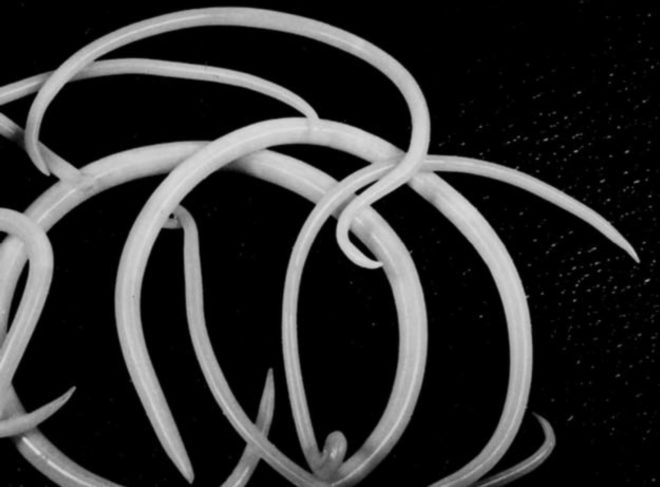

There are several types of parasites that infest domestic pigs.
Why appear
First of all, farmers need to understand what constitutes a disease. Helminthiasis is provoked by various parasites that enter the gastrointestinal tract of animals through food, or through contact with contaminated surrounding objects. Among the worms that most often enter the body of pigs, they usually find trematodes, cestodes, nematodes, ascaris, acanthocephalus. Most of these worms can also enter the human body, and also lead to the development of dangerous pathologies and ailments. Depending on the type of parasite, they affect certain internal organs.
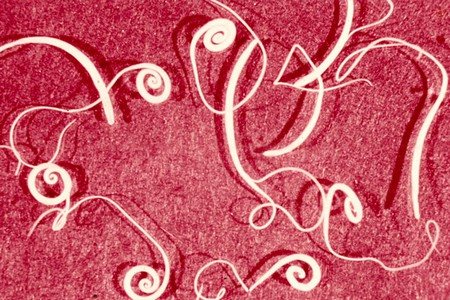

The development of worms in the body is quite intense, since females are able to lay thousands of eggs in a short period of time. Within 2-3 weeks, the cycle of development of new offspring of helminths is repeated, continuing to affect the immune system of the sick animal, the work of internal organs and the general condition.Very often, pigs eat various plants, seeds that are found in the ground. Therefore, the eggs of the worms enter the body along with this food. With rational feeding, parasites are less common, since these products are clean and stored in closed containers (buckets, bags).
Read also: Vietnamese Pig-bellied Pig: all about the breed
Sources of infection in pigs may include feces from sick animals. Also, newborn piglets can become infected with helminths through the milk of a lactating sow. If characteristic symptoms appear in small pigs, then they must be treated immediately, since pathology can lead to intense dehydration of the body.
At whatever age worms are found, it is possible to get rid of the disease only after a course of treatment. The body alone will not be able to eliminate the parasites that have begun to develop in the gastrointestinal tract.
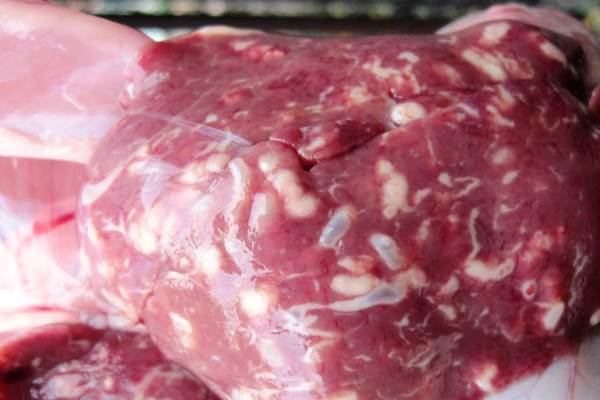

Preparations for the treatment of helminthiasis in pigs
Let's figure out what to give a pig from worms?
The number of drugs prescribed by veterinarians for deworming include:
- Hygromycin B - light gray powder from worms, which is effective against trichocephalosis and ascariasis.
- Nilverm - powder for preparation of injections. Even young pigs can be injected. Most often it is prescribed for ascariasis.
- Alvet - pellets that are added to pig feed.
- Alfven - tablets of a wide spectrum of action.
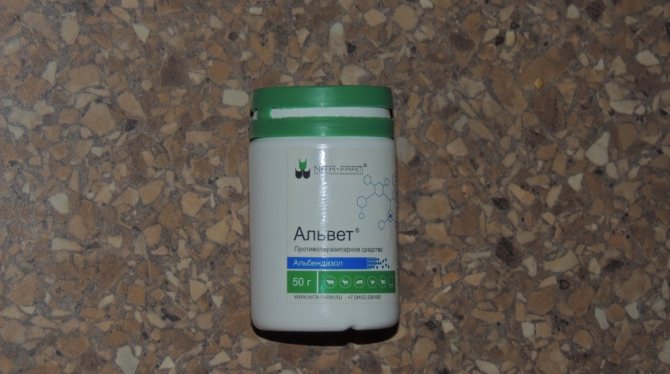

For the treatment of helminths in pigs, the drug Alvet is often used.
In fact, the list of antihelminthic drugs is quite wide. It should be understood that only a veterinarian who can calculate the optimal dosage can prescribe this or that medicine for worms.

